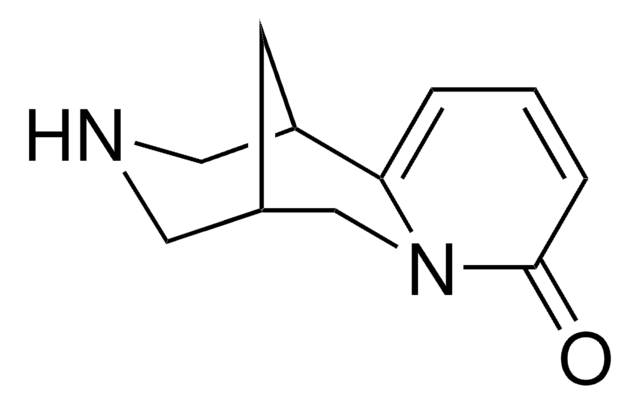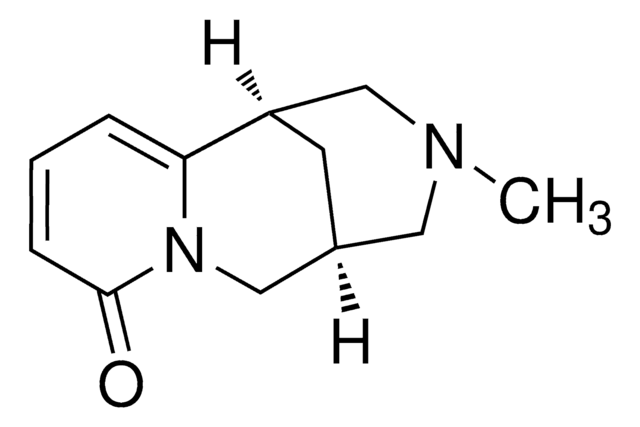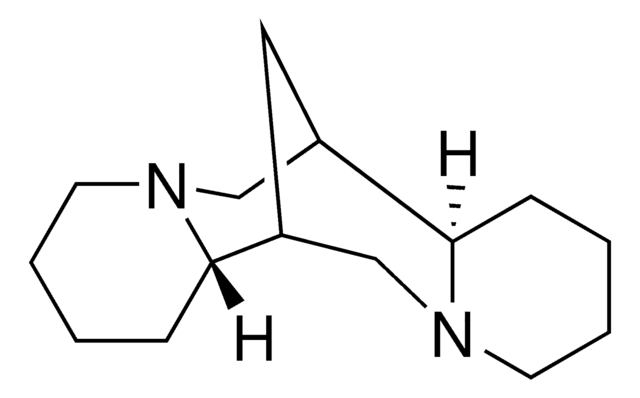Kluczowe dokumenty
C2899
Cytisine
≥99%, powder
Synonim(y):
(−)-Cytisine, (1R,5S)-1,2,3,4,5,6-Hexahydro-1,5-methano-8H-pyrido[1,2a][1,5]diazocin-8-one, (1S,9S)-3,11-Diazatricyclo[7.3.1.03,8]trideca-5,7-dien-4-one, Baptitoxin, Laburnin, Sophorine, Ulexine
About This Item
Polecane produkty
Poziom jakości
Próba
≥99%
Formularz
powder
kolor
light yellow
bp
218 °C/2 mmHg (lit.)
mp
154-156 °C (lit.)
ciąg SMILES
O=C1C=CC=C2C3CNCC(C3)CN12
InChI
1S/C11H14N2O/c14-11-3-1-2-10-9-4-8(5-12-6-9)7-13(10)11/h1-3,8-9,12H,4-7H2/t8-,9+/m0/s1
Klucz InChI
ANJTVLIZGCUXLD-DTWKUNHWSA-N
informacje o genach
rat ... Chrna2(170945) , Chrna3(25101) , Chrna4(25590)
Szukasz podobnych produktów? Odwiedź Przewodnik dotyczący porównywania produktów
Opis ogólny
Działania biochem./fizjol.
Cechy i korzyści
Hasło ostrzegawcze
Danger
Zwroty wskazujące rodzaj zagrożenia
Zwroty wskazujące środki ostrożności
Klasyfikacja zagrożeń
Acute Tox. 3 Dermal - Acute Tox. 3 Inhalation - Acute Tox. 3 Oral
Kod klasy składowania
6.1C - Combustible acute toxic Cat.3 / toxic compounds or compounds which causing chronic effects
Klasa zagrożenia wodnego (WGK)
WGK 3
Temperatura zapłonu (°F)
Not applicable
Temperatura zapłonu (°C)
Not applicable
Środki ochrony indywidualnej
Eyeshields, Faceshields, Gloves, type P2 (EN 143) respirator cartridges
Wybierz jedną z najnowszych wersji:
Masz już ten produkt?
Dokumenty związane z niedawno zakupionymi produktami zostały zamieszczone w Bibliotece dokumentów.
Nasz zespół naukowców ma doświadczenie we wszystkich obszarach badań, w tym w naukach przyrodniczych, materiałoznawstwie, syntezie chemicznej, chromatografii, analityce i wielu innych dziedzinach.
Skontaktuj się z zespołem ds. pomocy technicznej






